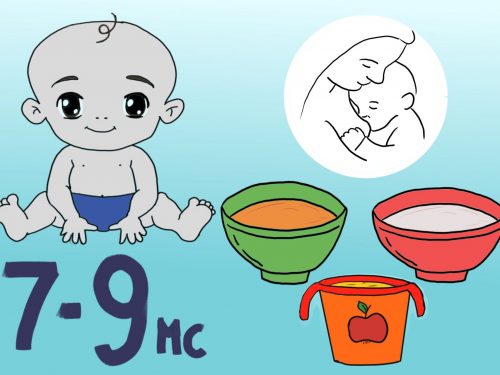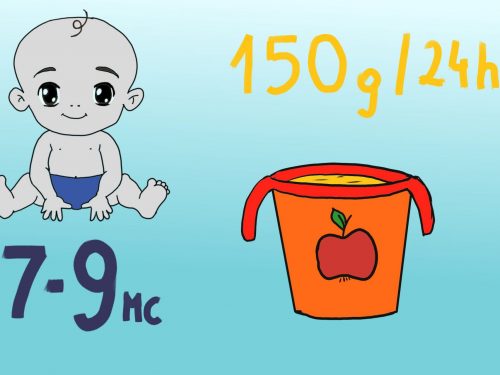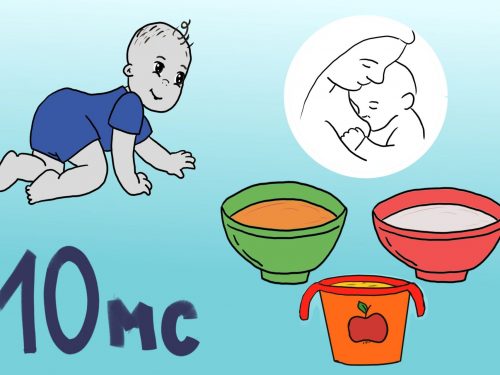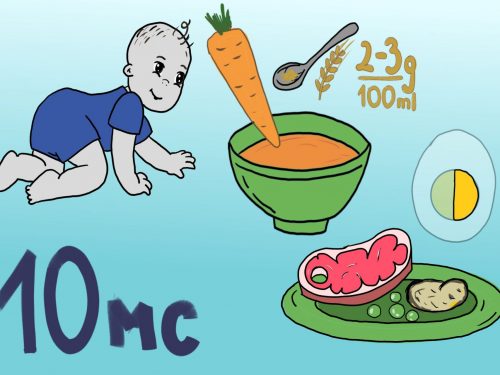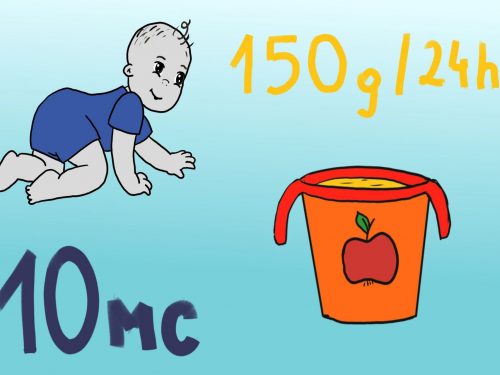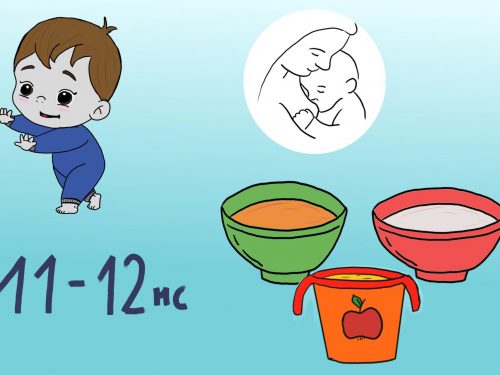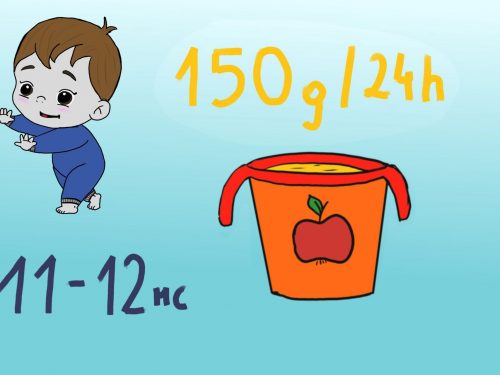
“There flies the spoon.” Principles of proper expansion of the diet in infants.
This is probably the most interesting and at the same time the most stressful moment in baby care. First meal other than MILK. How to start, what to serve, what consistency of food…? Questions literally flood every parent. You won’t serve your toddler your own dinner?! Today I will tell you about expanding your baby’s diet. It is based on knowledge from pediatrics books and articles published on this topic. Remember that this is not a set of rigid rules, only a time frame when a given product can be introduced into the toddler’s diet. I’m talking about a healthy child, i.e. without any allergies or food intolerances.
Before we move on to the rest of the article – if you prefer to listen/watch this material – the video is already available on my YT channel – click the link>>> https://youtu.be/f_0eZdH8-xY
The need to introduce food – i.e. complementary foods – into the infant’s diet results from the increasing demand for nutrients that milk alone can no longer provide. After all, your baby moves more and more and needs more and more calories. But slowly supplied milk is not enough to provide all the macro and micro nutrients. In addition to a boost of energy, the new food is expected to provide more iron, vitamins and fiber, etc.
And since everything is a learning experience for a baby, the same applies to expanding the diet – it exercises the mouth muscles, coordinates the opening of the mouth, swallowing food, and the tongue tests new structures. He practices the basics so that he can then learn how to bite.
We expand the diet of infants between 17 and 26 weeks of age.
The optimal age and order of introducing complementary foods into an infant’s diet is the subject of much debate, and practice varies significantly in many countries!
Why then?
Between 4 and 6 months of age in infants, the natural reflex to remove all foreign bodies from the mouth (e.g. a spoon or mushy food) disappears. During this time, the child also acquires the ability to maintain a semi-sitting position (sitting with support) and begins to control head and neck movements. These are signs that it is ready to absorb not only liquids, but also foods of a different consistency. I always recommend waiting for these signs of readiness to eat. Remember – don’t force it at first!
If you have any doubts about how to expand your child’s diet, discuss this topic with your doctor!
Which scheme should I choose?
The schedule for expanding the diet depends on the current feeding method.
- Babies exclusively breastfed start their adventure with 6 months of life.
- However, in infants who are fed formula milk (so-called artificial feeding), such nutrition can be started 1-2 months earlier. That’s even from 4 months of age (provided the child shows signs of readiness).
Before we move on to the entire nutrition regimen, it is worth starting with the most frequently asked questions.
Which complementary food should you choose at the beginning?
In Poland, the introduction of complementary foods most often begins with feeding the baby single-ingredient vegetable or fruit puree. You can also start by serving gluten-free porridge (e.g. rice porridge). However, there are no strict recommendations specifying what type of complementary food to introduce to an infant’s diet first.
To start with, I usually recommend gluten-free porridges or gruels, vegetable soups, fruit mousse, vegetable purees made from carrots, pumpkins, potatoes, parsley root , squash, beets, zucchini – these vegetables rarely cause allergies. Legumes, cabbage vegetables and spicy-tasting vegetables (onion, garlic, leek) should be served carefully because they are rather difficult to digest. It’s best to leave the fruit for later because it’s sweet. After such a meal, it is more difficult to convince the child to choose a more neutral taste.
Between 5th and 7th month we also introduce gluten porridge (semolina) or gluten gruel.Gluten at the beginning, give half a teaspoon (2-3 g) once a day in a small amount of vegetable puree, milk or water.
When introducing new foods, be sure to remember:
- Introduce new products:
- singly,
- gradually (e.g. every 3-5 days)
- in small amounts (3-4 teaspoons).
- Watch your child’s reaction carefully. This makes it easier to observe possible symptoms of food intolerance, such as:
- diarrhea,
- vomiting,
- skin changes,
- anxiety or excessive crying of the child
- Don’t introduce several new products at the same time.
- The order in which individual foods, e.g. vegetables, are introduced does not matter.
- > 10 months of age, vegetables and meat should be given in a consistency that stimulates chewing.
I have allergies, how can I know if my child is allergic to something, do I need to do any tests?
NO ! And unfortunately, you won’t know until your child tries the food himself. There are no allergy tests at this age that would show the possibility of allergies in the future. You need to try new products using trial and error and careful observation. .
How does expanding of the diet in infants look like – individual stages:
NATURALLY FED CHILDREN (BREASTFEEDING):
0-6 months – breast milk on demand
7-9 months –breastfeeding on demand plus complimentary meals – initially 1x and at the end of the 9th month 2-3x 
- vegetable soup or vegetable puree with cooked meat (1-2 times/week) – without broth, with gluten-free gruel – 2-3 g (half a teaspoon) per 100 ml of puree and with 1/2 cooked egg yolk every other day (from 7 months of age)
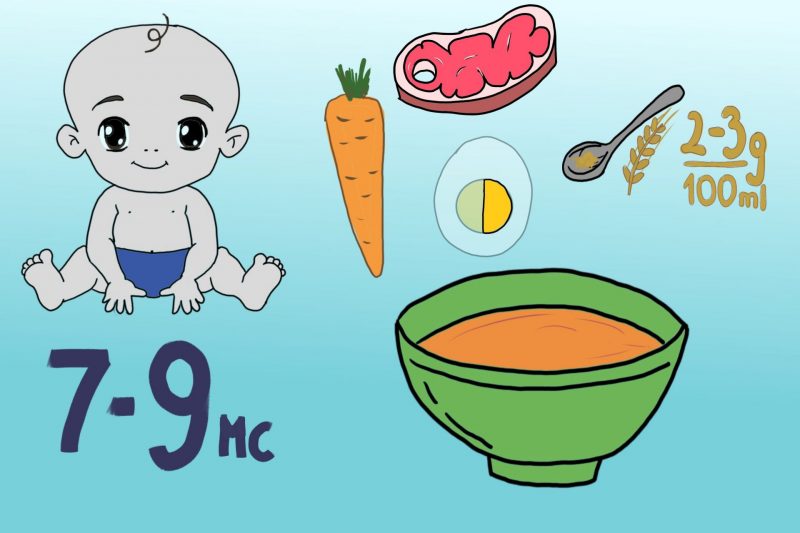
- gluten-free porridge or gruel (rice or corn) or with gluten

- fruit juice (preferably puree, unclarified) or fruit puree (no more than 150 g/day)
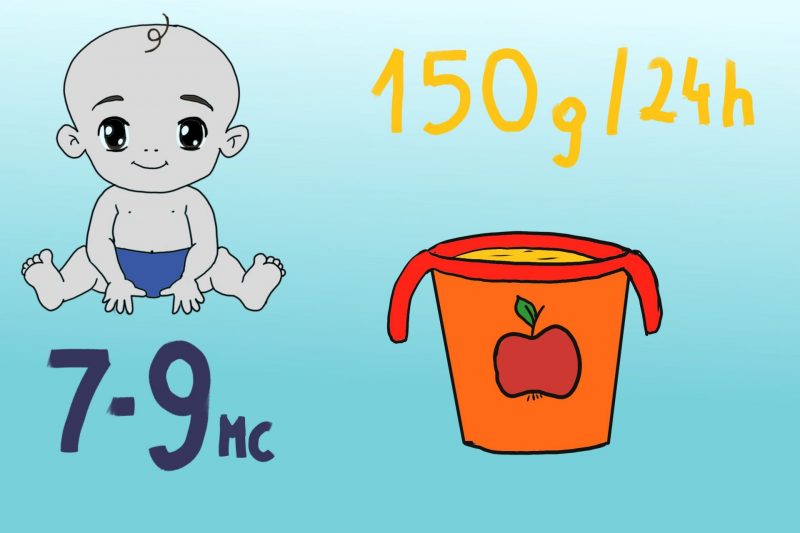
10 months –breastfeeding on demand plus 2-3 complementary meals 
- 2-course dinner: vegetable soup with gluten-free porridge + vegetables with boiled meat (1-2 times/week), 1/2 cooked egg yolk with meals every day
-

- Gluten and gluten-free porridges and gruels, a small amount of bread, sponge cakes, rusks

- fruit puree or juice (no more than 150 g/day

11-12 months –breastfeeding on demand plus 3 complementary meals 
- 2-course dinner: vegetable soup with gluten porridge + vegetables with boiled meat (1-2 times/week), optionally with potato or rice and a whole cooked egg (3-4 times/week)
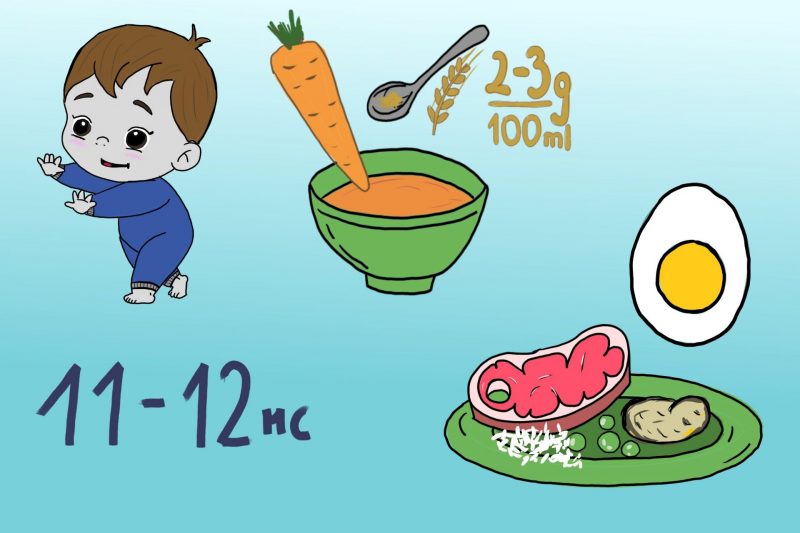
- cereal products (gluten and gluten-free porridges and gruels, bread, biscuits, rusks) combined with dairy products (e.g. infant formula, cottage cheese, yogurt, kefir – several times a week)
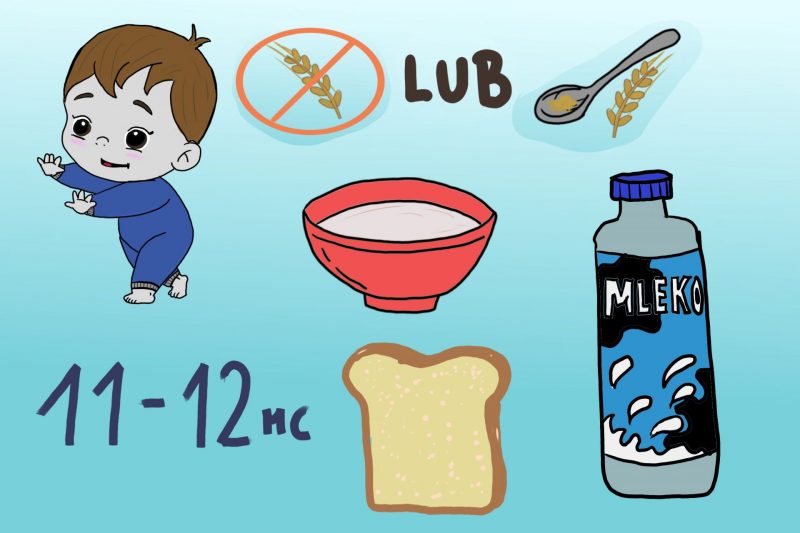
- fruit puree or juice (no more than 150 g/day)
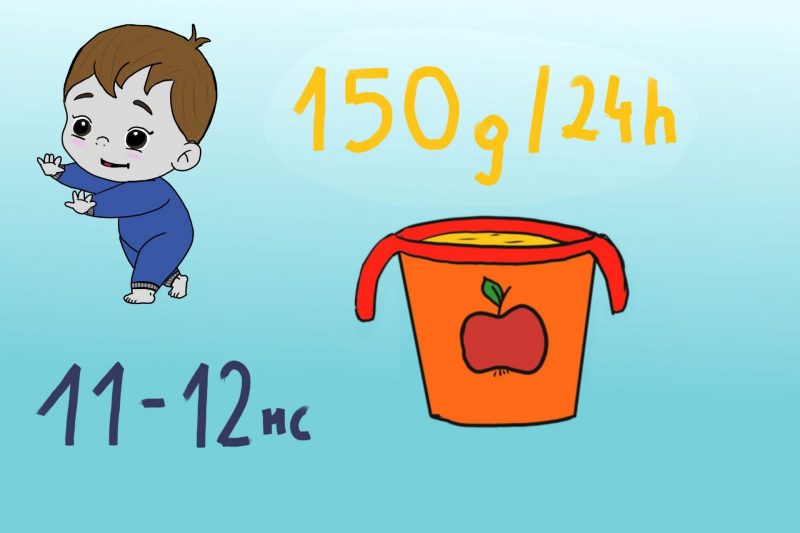
checklist here—> NATURALLY FED CHILDREN (BREASTFEEDING)
ARTIFICIALLY FEED CHILDREN (FEEDING WITH FORMULA)
1 mc infant milk 7x 100 ml
2 mc infant milk 6x 120 ml
3 mc infant milk 6x 130 ml
4 mc infant milk 6x 150 ml
5 mc -5 portions of 180 ml each:
- 4x infant milk
- 1x vegetable puree soup
- scraped apple or juice (preferably puree) – 50-100 g
6mc-5 portions of 180 ml each
- 4x follow-up baby milk
- 1 soup: vegetable puree + 10 g of cooked meat (without stock) or fish (1-2 times a week)
- fruit puree or juice (preferably puree), no more than 150 g
- introduction of gluten: 1 x daily half a teaspoon (2-3 g) of gluten porridge per 100 ml (for soup, milk or fruit)
7 months-5 meals
- 3x 180 ml follow-up baby milk
- 1 x soup: vegetable puree + 10 g of cooked meat or fish (1-2 times a week) + 1/2 cooked egg yolk every other day
- 1x 150 g gluten-free milk porridge or milk and fruit dessert
- fruit puree or juice (preferably puree), no more than 150 g
- introduction of gluten: 1 x daily half a teaspoon (2-3 g) of gluten porridge per 100 ml (for soup, milk or fruit)
8 months-5 meals
- 3x 180 ml of follow-up baby milk
- 1 x soup: vegetable puree + 10-15 g of cooked meat or fish (1-2 x per week) + 1/2 cooked egg yolk every other day
- 1×150 g gluten-free milk porridge or milk and fruit dessert
- fruit puree or juice (preferably puree), no more than 150 g
- introduction of gluten: 1 x daily teaspoon (6 g) of gluten porridge per 100 ml (for soup, milk or fruit)
9 months –5 meals
- 2 x 200 ml follow-up baby milk
- 1x 200 ml vegetable-meat or vegetable-fish dish (1-2 times a week) + ½ egg yolk daily
- 1x 200 ml of gluten porridge with follow-up milk or/and a milk and fruit dessert
- fruit puree or juice – no more than 150 g
10 mc 4-5 meals
- 3x 200 ml milk meal combined with cereal products (follow-up milk, gluten-free and gluten milk porridges, biscuits, rusks)
- lunch meal: 1x vegetable soup with gluten porridge
- 1x 200 ml vegetable and meat dish (15-20g) or vegetable and fish dish (1-2 times a week) + 1/2 cooked egg yolk daily
- 1x 200 ml of gluten porridge with follow-up milk and/or milk and fruit dessert
- fruit puree or juice – no more than 150 g
11 months -4-5 meals
- meals as in the 10th month
- Whole cooked egg 3-4 x / week
- dairy products: cottage cheese, kefir, yogurt – several times a week
check -list here—> ARTIFICIALLY FEED CHILDREN (FEEDING WITH FORMULA)
Remember that every child is different and has different taste preferences. It is not always possible to apply all the rules. I wish you a successful adventure in exploring together a new world of flavors, textures and… cleaning ;).
(Both diet expansion schemes come from the Pediatrics textbook edited by W. Kawalec, R Grenda i H. Ziółkowska)




